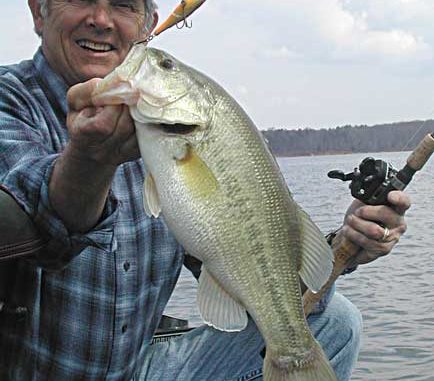
One of the nice things about fishing in November — besides the fact the fish will bite — is the lakes aren’t crowded. It’s deer season, and a lot of the people who fish nine or 10 months out of the year will be in the woods instead of at the lakes, leaving that much more water for you to explore.
November is really a good month; some of the best days I’ve ever had on the water were in November. The water hasn’t gotten cold enough to be winter, and the fall patterns are really working.
Most of the time I’m looking for bass to be fairly shallow; they won’t have moved to deep water yet. I’m going to catch most of my fish in 10 feet of water or less. A lot of fish will be very shallow in November, but they’ll be on places that are close to deep water. If you can find a good deep bank with wood, shallow stumps, rip-rap or shallow brushpiles, that bank will really produce some good fish.
I like to start in the backs of creeks and look out. At Buggs Island, for instance, you can go to the back of Grassy or Bluestone or any of those creeks, and if you find a place where the creek channel runs up against the bank, there should be a ton of fish on them.
And the really good part, what makes November so much fun, is that you’ll get into a lot of stripers that are in with the bass. The stripers might be a little deeper, but they’ll be on a lot of the same kinds of places. It’s the first month of the year when you can really catch ‘em on places where you usually catch bass. They’re too deep in the summer, but they’ll move up late in the fall and stay there through the winter. You never know what you’re going to catch on a crankbait if you’re fishing a lake that’s got stripers, a Buggs Island or a Gaston or Lake Norman.
I’m looking for deep banks and creek-channel swings. Fish will relate to those deep drops. A lot of times, you can catch seven or eight fish on a spot if you can find ‘em on a creek channel swing that’s got stumps or brush or rocks. They won’t necessarily be around points for a change. Those little channel swings are better.
I’ll usually start with a Rapala DT-10 crankbait, then maybe go to a DT-6 later in the day. You can fish a DT-10 shallow by not making as long a cast, but a DT-6 will come through those shallow stumps and trees and brushpiles better.
Going down a deep bank, you’re not likely to pull up on one stump and brushpile and catch a bunch of fish, but you can get on sections of bank that will be full of bass. You might go down a long section of deep bank and catch 20, but you won’t catch them all off the same spot. They won’t be bunched up, but you can find a lot of them in a general area if you can find a lot of baitfish there.
Color wise, there are about four you need to fish. You won’t need anything except the old Gray Ghost, your plum shad, brown and bone – which is super in the fall, and chartreuse with a brown back. Those are all you need. A lot of times, when bass really get keyed on in shad, it’s hard to be a crankbait with a brown back.
If I had to pick something to fish, it would be a deep, rip-rapped bank. In the fall, a lot of fish will be on those kinds of places, where you can have your boat in 15 to 18 feet of water and be casting to the rocks. Rip-rap will hold a tremendous number of fish in the fall. A lot of lakes don’t have rip-rap, but Lake Norman does, and Buggs Island and Gaston have a lot of banks with those big rocks on them. You want the rocks to fall off into deeper water. If they only come out two or three feet below the surface, they won’t hold as many fish.
You don’t really need to make extremely long casts this month like you do in November. In fact, you’re doing a lot of casting to targets – fishing around a stump, or a tree top where you need to make several casts to bring that bait across the trunk around the biggest limbs. I’ll put away my really long crankbait rods and normally use a 6-foot American RodSmith cranking stick. I still use 10-pound Rapala line, even with the possibility of getting hooked up with a 15-pound striper. If you’re patient and you’ve got a good drag system on your reel, you can land a big fish like that.
Hopefully, if you take these tips, you’ll have more to give thanks for at Thanksgiving than the turkey and dressing.
David Fritts is a 51-year-old pro bass fisherman from Lexington. He won the 1993 Bassmasters Classic champion, the 1997 FLW Tour Championship and the 1994 Bass Angler of the Year title. He is sponsored by Ranger boats, Evinrude outboards, Rapala, Zoom, VMC, American RodSmiths, Bass Pro Shops and Chevrolet.




Be the first to comment